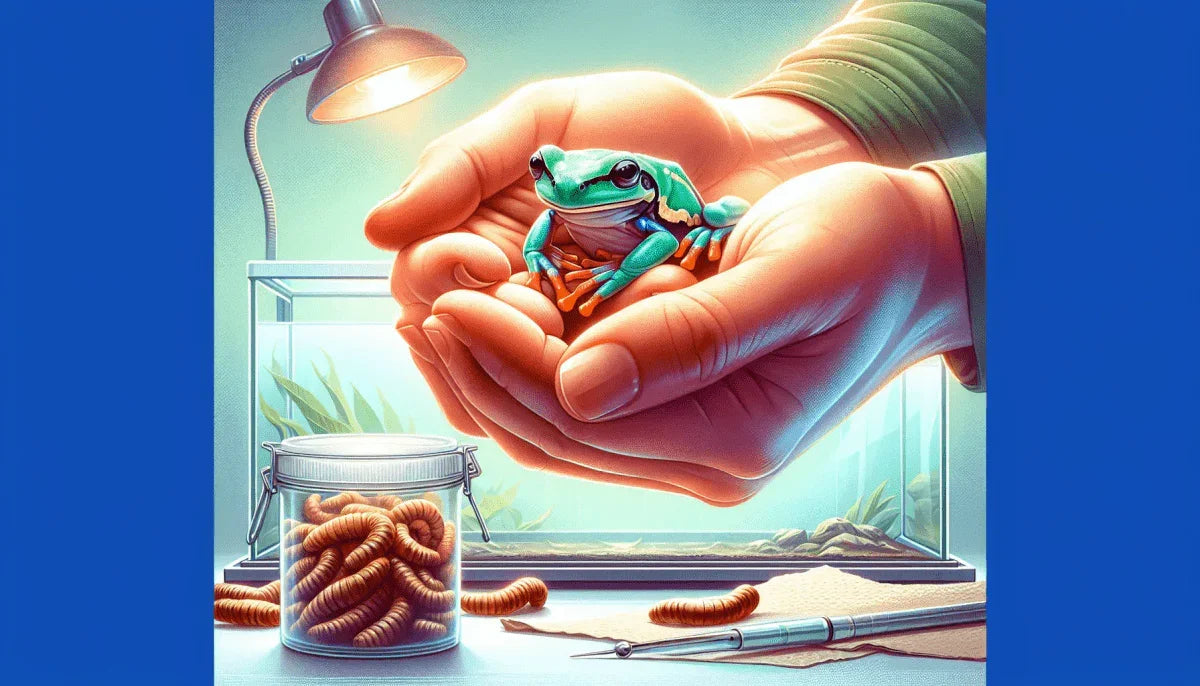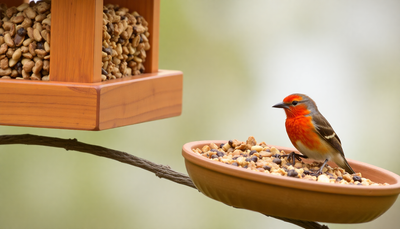Introduction to Pacman Frogs

Pacman Frogs hold a distinguished spot in the amphibian world, hailed for their vibrant appearance and unique behaviors. Originating from the rainforests of South America, these terrestrial frogs are known for their round shape and wide mouths, traits that resemble the iconic arcade game character, lending to their name. Mastery of Pacman Frog care is crucial for both potential and current owners to ensure these captivating creatures thrive in captivity, reflecting the conditions of their native habitats. Understanding their requirements is the cornerstone of responsible Pacman Frog stewardship, setting the stage for a healthy and fulfilling life for these exotic amphibians.
Pacman Frog Species Overview
The world of Pacman frogs is rich with variety, each species boasting its own unique characteristics. As hobbyists dive into the realm of these fascinating amphibians, understanding the subtle differences between species is not just a matter of curiosity—it's essential to providing the highest standard of care. These frogs, known scientifically as the genus Ceratophrys , vary widely in coloration, size, and even temperament.
Commonly kept species include the ornate Pacman frog and the green Pacman frog, both of which exhibit the trademark rounded body and large mouth that give this family of frogs its name. The ornate species is particularly prized for its vibrant, multicolored patterns, while the green varieties offer a more subdued, yet equally captivating, aesthetic.
Identifying the correct species of a Pacman frog is not simply an academic exercise. It plays a crucial role in tailoring the habitat to match the frog's specific environmental needs. A frog's geographic lineage, for instance, can influence its preference for temperature and humidity—factors that, if not properly managed, can significantly impact the frog's health and wellbeing. Caretakers must therefore be diligent in researching the natural habitats of their specific Pacman frog species to replicate these conditions as closely as possible within their terrariums.
From the arid scrublands to lush rainforests, the native environments of these species demand careful emulation. This includes selecting the appropriate substrate, maintaining the right moisture levels, and ensuring that the enclosure is furnished with hiding spots and foliage that reflect the frog's natural surroundings. By prioritizing the accurate identification of species, owners can create a sanctuary that not only supports the physiological needs of their Pacman frogs but also promotes natural behaviors for a truly thriving pet.
The Pacman Frog Lifestyle
Understanding the natural habitat and behavior of Pacman Frogs is essential for replicating the conditions they need in captivity. In the wild, these amphibians spend much of their time in warm, moist environments that are rich in vegetation and provide ample hiding spots. They tend to burrow and remain still for long periods, a behavior that aids in hunting prey and avoiding predators. This sedentary lifestyle is something owners must accommodate, ensuring their habitat in captivity offers similar opportunities for burrowing and resting.
The typical lifecycle of a Pacman Frog is also a fascinating journey from tadpole to adult. After hatching, the tadpole stage is aquatic, requiring a water-rich environment for development. As they mature, they undergo metamorphosis, a remarkable transformation during which they develop limbs and lung function for a more terrestrial lifestyle. Understanding these stages is paramount, as the care requirements for Pacman Frogs will vary greatly from their time as tadpoles to their fully developed adult form.
By examining these aspects of the Pacman Frog's lifestyle, we set a firm foundation for their care. This knowledge informs decisions on habitat setup, dietary needs, and interaction levels, ensuring these captivating creatures thrive under the watchful eye of dedicated owners.
Creating the Ideal Habitat
Embarking on the journey of Pacman Frog ownership begins with constructing a habitat that closely resembles their natural environment. This step is crucial in fostering a healthy and contented frog. The enclosure should not only serve as a containment area but also as a simulation of the frog's indigenous tropical surroundings, ensuring they feel secure and can exhibit natural behaviors.
To start, selecting the right size terrarium is essential. A space that's too cramped can cause stress, while an overly spacious one might make food hunting difficult for your amphibious pet. A general guideline is to provide a 10-gallon terrarium for a single frog, ensuring ample room for movement and exploration without being overwhelming.
Next, the choice of substrate is pivotal as it forms the foundation of the habitat. It should be a material that retains moisture well to maintain the necessary humidity levels, such as coconut fiber or sphagnum moss. These substrates are not only absorbent but also soft enough to prevent injuries and resemble the frog's natural bedding in the wild.
Decorations are more than just aesthetic enhancements; they recreate the structural complexity of a frog's natural habitat. Include features such as broad-leafed plants, either live or artificial, to provide shelter and shade. Additionally, a hideaway spot is important for your frog's sense of security, allowing them a retreat for rest and seclusion.
By thoughtfully setting up the terrarium, you create more than a home; you craft an ecosystem where your Pacman Frog can thrive. This careful replication of their natural environment pays homage to their origins and caters to their instinctual needs, paving the way for a healthy and fulfilling life in captivity.
Temperature and Humidity Requirements
Ensuring your Pacman Frog thrives means closely replicating its native tropical habitat, particularly the temperature and humidity levels. The ideal temperature range for a Pacman Frog's health and comfort falls between 75 and 85 degrees Fahrenheit during the day, slightly cooler at night. As for humidity, these amphibians flourish in an environment with 50-80% humidity, crucial for their hydration and overall well-being.
To maintain these conditions, several methods can be employed. Heating devices such as under-tank heaters or ceramic heat emitters are excellent for keeping the temperature consistent. It's vital, however, to monitor the warmth provided to avoid overheating your frog's living space. A reliable thermostat can prevent temperature fluctuations that could stress or harm your amphibious pet.
When it comes to humidity, misting the enclosure daily is a straightforward technique. Automated misting systems or manual spray bottles can help achieve the desired moisture levels. Additionally, providing a sizable water dish not only contributes to the habitat's humidity but also allows your Pacman Frog to soak as it would in the wild. Remember, the water used should be dechlorinated to avoid irritating the frog's sensitive skin.
The balance of temperature and humidity is more than a comfort; it's a necessity for your Pacman Frog's health. Regular checks with thermometers and hygrometers will assist in creating a stable environment, preventing common issues such as respiratory infections or shedding problems. With the right equipment and attentive care, your Pacman Frog will have a cozy and safe enclosure to call home.
Lighting and Light Cycles
Leveraging the right lighting is pivotal for mimicking a Pacman Frog's natural environment and maintaining its circadian rhythm. In the wild, these frogs are accustomed to the consistent rise and fall of the sun, which dictates their daily activities. Capturing this essence in a terrarium demands a strategic approach to lighting.
A crucial factor to consider is the balance of light and dark periods. Pacman Frogs do not require direct sunlight but do need a cycle that simulates dawn to dusk, typically 12 hours of light followed by 12 hours of darkness. This can be achieved through the use of timers attached to the terrarium lighting setup, ensuring consistency without manual intervention.
It's essential to select lighting that emits low levels of heat to avoid disrupting the terrarium's temperature balance. Light fixtures designed for reptiles can offer a suitable spectrum without elevating the temperature, thus safeguarding the Pacman Frog's delicate habitat conditions.
Remember, while lighting supports the visual aesthetics of the habitat, its primary role is to bolster the well-being of the Pacman Frog. The integration of a well-structured light cycle contributes to the frog's overall health, influencing behaviors such as feeding and sleeping patterns.
Diet & Nutrition
Understanding the nutritional needs of Pacman Frogs is crucial for their health and longevity. These amphibians have specific dietary requirements that, when met, lead to a thriving life. A Pacman Frog's diet consists primarily of live prey, including crickets, mealworms, and even small feeder fish. The natural hunting instincts of these frogs are stimulated when they are offered food that moves, which is vital for their mental well-being.
Feeding schedules for Pacman Frogs vary depending on age and size. Juveniles require daily feeding due to their rapid growth, while adults thrive on a meal every two or three days. It's important to offer appropriately sized prey to prevent choking or digestive issues. As a general rule, the size of the food item should not exceed the width of the frog's mouth.
To ensure well-rounded nutrition, dietary supplements are key. Dusting food with a high-quality calcium supplement is necessary to prevent metabolic bone disease, a common ailment in captive amphibians. Additionally, a multivitamin supplement should be used periodically to cover any other nutritional gaps. Consistency with supplementation is vital, as it helps avoid both deficiencies and potential toxicities.
Maintaining the delicate balance of a Pacman Frog's diet requires attention and knowledge. By providing live, nutritious prey and supplementing with essential vitamins and minerals, you can support your Pacman Frog's health and watch them flourish in their habitat.
Health & Hygiene
Ensuring the health and longevity of your Pacman Frog begins with understanding common health concerns and the signs that may indicate a problem. These amphibians can suffer from various ailments, but with proper care, many issues are preventable. Keep an eye out for symptoms such as lethargy, lack of appetite, discoloration, or bloating, which could signal that your frog is not at its peak health. Immediate attention to such signs is crucial, as they can quickly escalate if left unaddressed.
Preventative care plays a pivotal role in maintaining your Pacman Frog's well-being. A cornerstone of this is a clean and hygienic habitat. Regular cleaning of the terrarium, including substrate changes and disinfection of surfaces, helps prevent the buildup of harmful bacteria and fungi. Additionally, ensuring that any water source within the habitat is clean and free of contaminants is vital, as amphibians are highly susceptible to pollutants and toxins absorbed through their permeable skin.
Maintaining a pristine environment for your Pacman Frog is not just about cleanliness; it's about creating a foundation for health and vitality. By staying diligent with habitat hygiene, you're not only warding off potential diseases but also providing a space where your Pacman Frog can thrive.
Handling and Interaction
When it comes to caring for Pacman Frogs, understanding the nuances of handling and interaction is crucial. These amphibians are not as interactive as other pets, and they require a specific approach to ensure their well-being. It's essential to recognize that the tranquility of their environment heavily influences their health and stress levels.
Pacman Frogs have delicate skin that can easily absorb harmful substances, which is why it's paramount to handle them with clean, wet hands to minimize the risk of irritation or injury. Always support their entire body gently, avoiding any tight grips that could cause discomfort or harm.
The frequency of interaction with your Pacman Frog should be kept to a minimum. These creatures are not social in the same way dogs or cats might be, and they do not require the same level of engagement. Overhandling can lead to stress, which may manifest in health issues or changes in behavior. Observing your frog in its habitat, allowing it to live as undisturbed as possible, contributes to a serene environment that promotes the well-being of your pet.
By adhering to these best practices for handling and maintaining a peaceful habitat, you can foster a healthy and stress-free life for your Pacman Frog, ensuring that both you and your amphibious friend enjoy a fulfilling companionship.
Ongoing Care and Maintenance
Maintaining the health and happiness of a Pacman Frog requires a consistent and diligent care routine. Ensuring your amphibian companion thrives involves regular upkeep of their habitat, a watchful eye on their health, and an understanding of their unique needs. Let's walk through the essential tasks that should be part of your Pacman Frog's care schedule.
Firstly, monitoring the terrarium conditions daily is crucial. Check that the temperature and humidity levels are within the ideal range for your frog's comfort and adjust your heating and misting systems as needed. It's important to keep these conditions stable to mimic the frog's natural environment and prevent stress.
Weekly, it's time to refresh the enclosure. This includes cleaning or replacing the water in the frog's dish and removing any waste or uneaten food to prevent the growth of bacteria and mold. Inspect the substrate for dampness and cleanliness, as a soiled substrate can lead to health issues such as skin infections or respiratory problems.
Monthly, a more thorough cleaning is in order. This involves replacing the substrate entirely and sanitizing the enclosure and all decor. Use frog-safe cleaning agents and ensure everything is rinsed thoroughly to remove any residue.
In addition to habitat maintenance, observing your Pacman Frog's behavior and physical condition is vital for early detection of potential health issues. If you notice any changes in appetite, activity level, or skin texture, consult a veterinarian experienced with amphibians.
Remember, while your Pacman Frog may not require daily interaction, the care you provide is paramount to their well-being. With this routine, your frog can lead a long, healthy life under your watchful care.
Talis-us and Your Pacman Frog Care Journey
As you delve into the world of Pacman frog care, consider Talis-us your ally on this captivating journey. Talis-us stands out as a hub for pet care products, where you may find items that cater to the specific needs of amphibians, including your Pacman frog. It's essential to create an environment that closely mirrors their natural habitat, and Talis-us may have just the right enhancements for your frog's home.
We encourage you to browse through Talis-us's selection. There, you might discover habitat accessories that can transform your Pacman frog's living space into a haven that supports their health and well-being. Additionally, nutritional supplements available could play a vital role in fulfilling your amphibious friend's dietary requirements, ensuring they receive all the necessary nutrients for a thriving life.
Incorporating the right products into your Pacman frog's care routine can make all the difference. With Talis-us, you have access to a variety of options that could contribute significantly to the quality of care you provide. Take the time to explore and select those products that will best suit the needs of your unique pet.
Embrace Pacman Frog Care
Caring for your Pacman Frog involves a dedicated approach to their unique needs, from creating a comfy habitat to providing a balanced diet. Remember, these fascinating amphibians thrive in environments that reflect their natural ecosystem, with the right blend of humidity and warmth. Thoughtful feeding, regular habitat maintenance, and minimal handling contribute to their well-being.
At Talis-us, we understand the importance of quality care for your pets. While our offerings are not specifically tailored to Pacman Frogs, we do provide a range of pet care products that could support your amphibian care routines, such as the TropicZone Box Turtle Diet which may be suitable for other amphibian species after proper verification. Explore our collection for your pet care needs.






